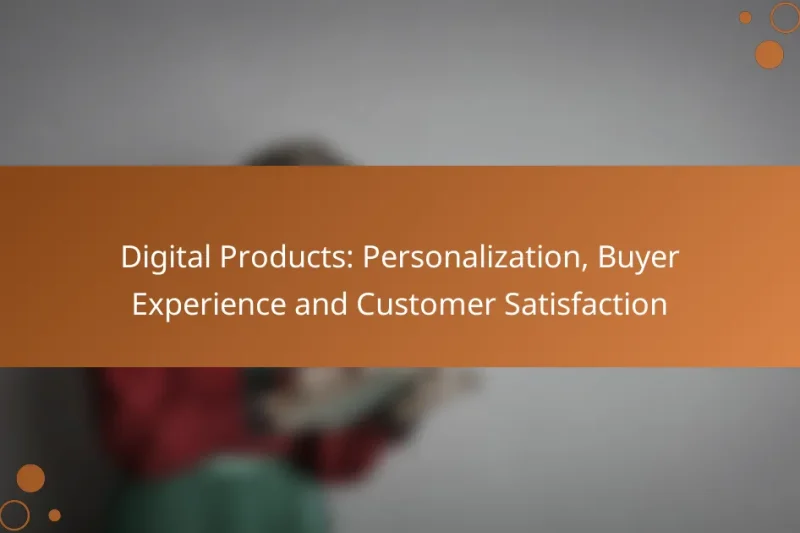In the realm of digital products, feedback loops play a crucial role in enhancing user experience … Digital Products: Feedback Loops, User Experience and Publishing EnhancementRead more
Digital Products: Customer Engagement Techniques
In the competitive landscape of digital products, effective customer engagement techniques are essential for fostering loyalty and enhancing user experience. By utilizing personalized communication, interactive features, and community involvement, businesses can create meaningful interactions that keep customers satisfied and invested. Additionally, leveraging data analytics allows companies to gain insights into customer behavior, enabling them to tailor their strategies for maximum impact.
Digital Products: Community Building, Engagement Strategies and Long-term Loyalty
Digital products play a crucial role in community building by offering platforms that promote interaction and … Digital Products: Community Building, Engagement Strategies and Long-term LoyaltyRead more
Digital Products: Gamification, User Interaction and Content Engagement
Gamification is a powerful tool in digital products, enhancing user interaction by incorporating game-like elements that … Digital Products: Gamification, User Interaction and Content EngagementRead more
Digital Products: Webinars, Audience Engagement and Educational Content
Webinars have become a vital tool for delivering educational content and engaging audiences in real-time. By … Digital Products: Webinars, Audience Engagement and Educational ContentRead more
Digital Products: Customer Engagement Metrics, Measurement Techniques and Insights
In the realm of digital products, customer engagement metrics play a crucial role in understanding user … Digital Products: Customer Engagement Metrics, Measurement Techniques and InsightsRead more
Digital Products: Personalization, Buyer Experience and Customer Satisfaction
In the realm of digital products, personalization plays a crucial role in enhancing the buyer experience … Digital Products: Personalization, Buyer Experience and Customer SatisfactionRead more
Digital Products: Loyalty Programs, Customer Retention and Engagement Strategies
In the competitive landscape of digital products, loyalty programs play a crucial role in enhancing customer … Digital Products: Loyalty Programs, Customer Retention and Engagement StrategiesRead more
What are effective customer engagement techniques for digital products?
Effective customer engagement techniques for digital products focus on creating meaningful interactions that enhance user experience and foster loyalty. These techniques leverage personalized communication, interactive elements, and community involvement to keep customers engaged and satisfied.
Personalized email marketing
Personalized email marketing involves tailoring messages to individual customer preferences and behaviors. By segmenting your audience based on their past interactions, you can send targeted promotions or content that resonates with their interests.
Consider using customer names, recommending products based on previous purchases, or sending birthday discounts. This approach can significantly increase open rates and conversions, often by double digits.
Interactive content
Interactive content engages users by allowing them to participate actively rather than passively consuming information. Examples include quizzes, polls, and interactive infographics that encourage users to explore and engage with your brand.
This type of content not only captures attention but also provides valuable insights into customer preferences. Aim to create content that is easy to share, as this can amplify your reach and foster community interaction.
Social media engagement
Social media engagement involves actively interacting with customers on platforms like Facebook, Instagram, and Twitter. Responding to comments, sharing user-generated content, and hosting live Q&A sessions can build a strong community around your brand.
Regularly posting engaging content and encouraging discussions can enhance customer loyalty. Aim to respond to inquiries within a few hours to maintain a positive relationship and show that you value customer feedback.
Gamification strategies
Gamification strategies incorporate game-like elements into your digital products to motivate and engage users. This can include rewards, challenges, and leaderboards that encourage users to interact more frequently with your offerings.
For instance, a fitness app might reward users with points for completing workouts, which can be redeemed for discounts. This approach not only makes the experience more enjoyable but can also drive user retention.
Customer feedback loops
Customer feedback loops are processes that allow you to gather, analyze, and act on customer feedback continuously. Implementing surveys, feedback forms, or direct interviews can provide insights into user satisfaction and areas for improvement.
Regularly reviewing this feedback and making necessary adjustments can enhance the user experience and demonstrate that you value customer opinions. Aim to close the loop by informing customers about changes made based on their input, which can further strengthen their loyalty.
How can digital products enhance user experience?
Digital products can significantly enhance user experience by providing intuitive interactions, seamless navigation, and personalized content. These elements contribute to user satisfaction and retention, making it essential for businesses to focus on effective engagement techniques.
User-friendly interfaces
User-friendly interfaces are crucial for ensuring that users can easily navigate digital products. A clean layout, clear labeling, and logical flow help users find what they need without frustration. Consider using familiar design patterns and minimizing clutter to enhance usability.
Incorporating feedback mechanisms, such as tooltips or error messages, can guide users effectively. Regularly testing your interface with real users can reveal pain points and areas for improvement, leading to a more satisfying experience.
Responsive design
Responsive design ensures that digital products function well across various devices and screen sizes. This adaptability is vital as users increasingly access content on smartphones, tablets, and desktops. A responsive layout adjusts elements dynamically, maintaining usability regardless of the device.
To implement responsive design, use flexible grids, images, and CSS media queries. Prioritize mobile-first design, as it often leads to better performance and user engagement. Regularly test your product on multiple devices to ensure consistent experiences.
Onboarding tutorials
Onboarding tutorials help users understand how to use digital products effectively. These tutorials can take various forms, such as guided walkthroughs, tooltips, or video demonstrations. A well-designed onboarding process can reduce user frustration and increase retention rates.
Keep onboarding concise and focused on key features that enhance user experience. Consider offering optional tutorials for advanced features, allowing users to explore at their own pace. Regularly update onboarding content based on user feedback to ensure it remains relevant and helpful.
What role does data analytics play in customer engagement?
Data analytics is crucial for enhancing customer engagement as it provides insights into customer behavior, preferences, and interactions. By leveraging analytics, businesses can tailor their strategies to meet customer needs more effectively, ultimately driving loyalty and satisfaction.
Behavior tracking
Behavior tracking involves monitoring customer interactions across various touchpoints, such as websites, apps, and social media. This data helps businesses understand how customers navigate their platforms, which features they use most, and where they drop off. For instance, tracking clicks and time spent on specific pages can reveal what captures attention and what needs improvement.
To implement behavior tracking effectively, consider using tools like Google Analytics or Hotjar. These platforms can provide heatmaps and session recordings, allowing you to visualize user behavior and make informed adjustments to enhance engagement.
Segmentation analysis
Segmentation analysis categorizes customers based on shared characteristics, such as demographics, purchasing behavior, or engagement levels. This approach enables businesses to tailor their marketing efforts and communications to specific groups, increasing relevance and effectiveness. For example, a company might segment its audience into new customers, repeat buyers, and high-value clients to deliver targeted promotions.
When conducting segmentation analysis, utilize data from customer surveys, purchase history, and website interactions. This will help you create more personalized experiences that resonate with each segment, ultimately boosting engagement rates.
Performance metrics
Performance metrics are essential for evaluating the effectiveness of customer engagement strategies. Key metrics include customer retention rates, engagement scores, and conversion rates. Monitoring these indicators allows businesses to assess what works and what needs adjustment. For instance, if engagement scores drop, it may indicate that content is no longer resonating with the audience.
To track performance metrics effectively, establish clear goals and benchmarks. Use tools like CRM systems or analytics dashboards to visualize data trends over time, enabling you to make data-driven decisions that enhance customer engagement.
How can businesses measure customer engagement?
Businesses can measure customer engagement through various metrics that reflect how customers interact with their products and services. Key methods include assessing customer feedback, tracking usage patterns, and analyzing satisfaction levels.
Net Promoter Score (NPS)
The Net Promoter Score (NPS) gauges customer loyalty by asking how likely customers are to recommend a business to others. Responses are typically on a scale from 0 to 10, categorizing customers as promoters, passives, or detractors.
To calculate NPS, subtract the percentage of detractors from the percentage of promoters. A score above 0 is generally considered good, while scores above 50 are excellent. Regularly measuring NPS can help identify trends in customer sentiment over time.
Customer Satisfaction Score (CSAT)
Customer Satisfaction Score (CSAT) measures how satisfied customers are with a specific interaction or overall experience. This is often assessed through a simple survey question, such as “How satisfied were you with your experience?” with responses on a scale from 1 to 5.
CSAT scores are calculated by dividing the number of satisfied customers (typically those who rate 4 or 5) by the total number of respondents, then multiplying by 100. A CSAT score of 80% or higher is generally seen as favorable.
Engagement metrics
Engagement metrics encompass various data points that indicate how customers interact with a brand. Common metrics include session duration, page views, and frequency of visits, which help businesses understand user behavior.
For digital products, tracking metrics like active users, click-through rates, and conversion rates can provide insights into customer engagement. Regularly reviewing these metrics allows businesses to adjust strategies and improve customer experiences effectively.
What are the prerequisites for implementing customer engagement strategies?
To effectively implement customer engagement strategies, businesses need a clear understanding of their target audience and the right tools for communication. This includes having a robust digital infrastructure and a commitment to ongoing interaction with customers.
Understanding your target audience
Knowing your target audience is crucial for successful engagement. This involves gathering data on customer preferences, behaviors, and demographics. Utilize surveys, social media analytics, and customer feedback to create detailed buyer personas that guide your engagement efforts.
Consider segmenting your audience based on factors like age, location, and purchasing habits. This allows for tailored messaging that resonates with specific groups, enhancing the effectiveness of your strategies.
Choosing the right communication channels
Selecting appropriate communication channels is essential for reaching your audience effectively. Common channels include email, social media, and mobile apps. Each channel has its strengths; for instance, email is great for detailed information, while social media excels in real-time interaction.
Evaluate where your audience spends their time and prioritize those channels. Regularly review engagement metrics to determine which platforms yield the best results and adjust your strategy accordingly.
Investing in technology and tools
Implementing customer engagement strategies requires the right technology and tools. Customer Relationship Management (CRM) systems, marketing automation platforms, and analytics tools can streamline your efforts and provide valuable insights.
Invest in tools that integrate well with your existing systems and offer scalability as your business grows. Regular training for your team on these tools ensures they are utilized effectively, maximizing your engagement potential.
Establishing a feedback loop
Creating a feedback loop is vital for continuous improvement in customer engagement. Encourage customers to share their experiences and opinions through surveys, reviews, and direct communication. This feedback helps identify areas for enhancement and fosters a sense of community.
Implement changes based on customer input and communicate these updates back to them. This not only improves your offerings but also shows customers that their opinions are valued, strengthening their loyalty.






